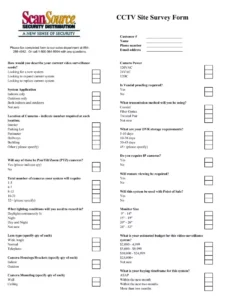Embarking on a fiber optic cable installation project is an exciting venture, promising high-speed connectivity and robust network infrastructure. However, before a single trench is dug or a cable is laid, there’s a crucial first step that often determines the entire project’s success or failure: the site survey. Think of it as mapping your journey before you even start the engine. A thorough site survey helps identify potential hurdles, ensures proper planning, and ultimately saves time and money. It’s about understanding the unique characteristics of your environment and tailoring your installation approach accordingly.
This initial scouting mission is where a well-structured fiber optic cable install site survey template becomes an invaluable asset. It’s not just a checklist; it’s a comprehensive guide that prompts you to gather all the necessary data points, from physical dimensions and existing infrastructure to environmental considerations and potential safety hazards. By using a standardized template, you ensure consistency across projects, minimize oversights, and create a clear, actionable plan for your installation team, leading to a smoother, more efficient, and safer deployment.
The Essential Role of a Comprehensive Site Survey
A detailed site survey forms the backbone of any successful fiber optic deployment. It’s the stage where you transition from abstract plans to concrete realities, identifying every nuance that could impact the installation process. Without a robust survey, you risk encountering unexpected obstacles mid-project, leading to costly delays, budget overruns, and a significant amount of frustration. Imagine discovering an unmarked utility line after you’ve started digging, or realizing that the planned cable pathway is too narrow for your chosen conduit. These are the kinds of issues a proper survey aims to prevent.
The survey process involves meticulous data collection, focusing on both the obvious and the subtle aspects of the installation environment. This includes everything from the geographical layout and building schematics to the availability of power, the condition of existing pathways, and potential environmental factors like extreme temperatures or moisture. It’s about creating a holistic picture that informs every subsequent decision, from cable type selection and routing to equipment placement and termination points. Essentially, you’re gathering intelligence that empowers your team to make informed choices and anticipate challenges before they arise.
Key Sections to Include in Your Template
When developing or utilizing a fiber optic cable install site survey template, certain sections are non-negotiable for capturing critical information. These categories ensure that no vital detail is overlooked, contributing to a robust and reliable installation plan. Each section serves a specific purpose, contributing to the overall intelligence gathered for the project.
Here are some fundamental areas your template should cover:
- Client and Project Information: Basic details such as client name, contact information, project scope, desired outcomes, and key stakeholders. This ensures clear communication and alignment.
- Site Details and Access: Comprehensive information about the physical location, including address, GPS coordinates, building type, floor plans, and specific access requirements for personnel and equipment.
- Existing Infrastructure Assessment: A thorough review of any current network infrastructure, available conduit, cable trays, raceways, or existing fiber optic lines. This helps in planning integration or upgrades.
- Environmental and Safety Considerations: Identification of environmental factors like temperature, humidity, potential water sources, and any safety hazards such as hazardous materials, high voltage areas, or confined spaces.
- Power Requirements and Availability: Details on power sources, voltage, amperage, and any need for new electrical installations or upgrades to support network equipment.
- Pathway and Route Analysis: Detailed mapping of the proposed cable routes, noting distances, obstacles (e.g., walls, floors, underground utilities), entry points, and termination locations. Include measurements and photographs.
- Equipment Placement: Specific locations for network equipment like switches, patch panels, splice enclosures, and optical network terminals (ONTs), considering space, cooling, and power access.
Incorporating these detailed sections into your fiber optic cable install site survey template ensures that you’re not just checking boxes but actively building a comprehensive understanding of your project site. It empowers your team with the data needed to design and implement a resilient, high-performing fiber optic network that meets the client’s needs and stands the test of time.
Tailoring Your Template for Optimal Project Execution
While a standard fiber optic cable install site survey template provides an excellent foundation, the true art lies in adapting it to the specific demands of each unique project. Not every installation is the same; an outdoor campus deployment will have vastly different requirements than an indoor data center build-out. Customizing your template ensures that you’re collecting the most relevant information for your particular scenario, streamlining the survey process and preventing the collection of unnecessary data that could clutter your reports. This adaptability is key to maintaining efficiency and focus.
Consider the nature of the environment you’re working in. For example, an outdoor survey might require more emphasis on soil conditions, weather patterns, existing underground utilities, and the presence of wildlife or challenging terrain. You would likely need sections for conduit trenching depths, bore path considerations, and even foliage management. Conversely, an indoor survey might focus more on fire ratings for cables, plenum spaces, ventilation systems, cable tray capacity, and the precise measurements of server racks or communication closets. Being able to toggle or add specific sections based on these distinctions makes your template incredibly powerful.
Furthermore, integrating modern tools and technologies into your survey process can significantly enhance the accuracy and efficiency of your data collection. Instead of relying solely on pen and paper, leverage tablets for digital forms, GPS devices for precise location mapping, laser rangefinders for accurate measurements, and high-resolution cameras for detailed visual documentation. Incorporating these technologies directly into your workflow means that data can be captured, stored, and shared more effectively, reducing errors and speeding up the subsequent planning phases.
The survey isn’t just about collecting data; it’s also about documenting it in a clear, unambiguous way. Utilize diagrams, floor plans, and annotated photographs to supplement your written notes. This visual information is often far more impactful and easier to interpret than text alone, especially when communicating complex details to the installation team. A well-documented survey serves as a vital reference point throughout the entire project lifecycle, minimizing misunderstandings and ensuring that everyone involved is working from the same precise set of information.
The meticulous preparation invested in a comprehensive site survey, guided by a well-designed template, significantly reduces the likelihood of unforeseen complications during the actual installation. It transforms a potentially chaotic endeavor into a structured and predictable process, allowing for precise resource allocation and adherence to timelines. This proactive approach minimizes costly reworks and ensures that the deployed fiber optic infrastructure meets the highest standards of performance and reliability.
By diligently following the insights gained from your detailed site survey, you lay a solid groundwork for a smooth and successful project. This foundational work empowers your team to execute the installation with confidence, delivering a robust and future-proof network solution that fully satisfies the client’s connectivity needs.



